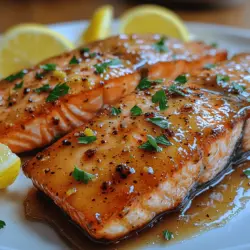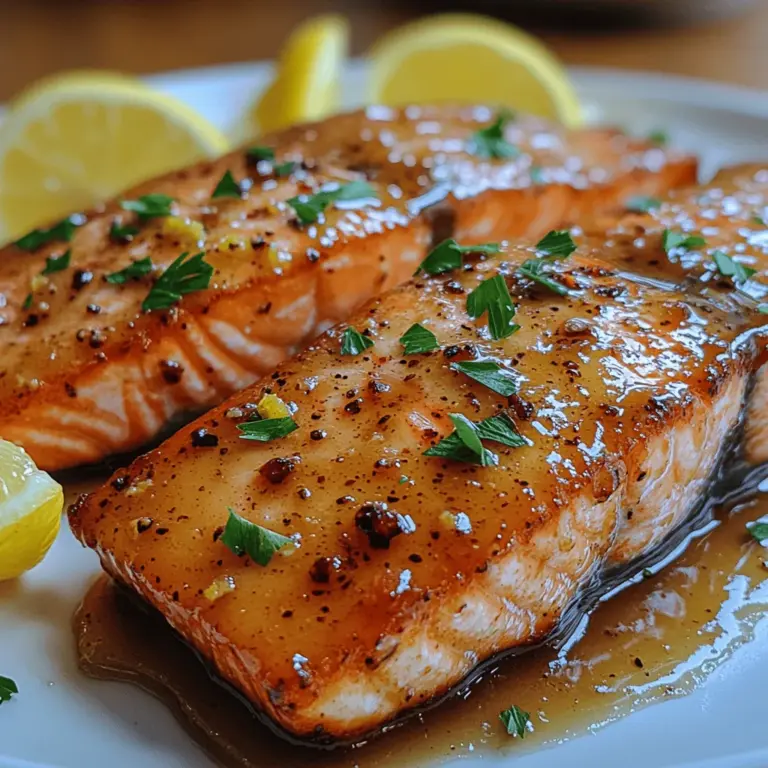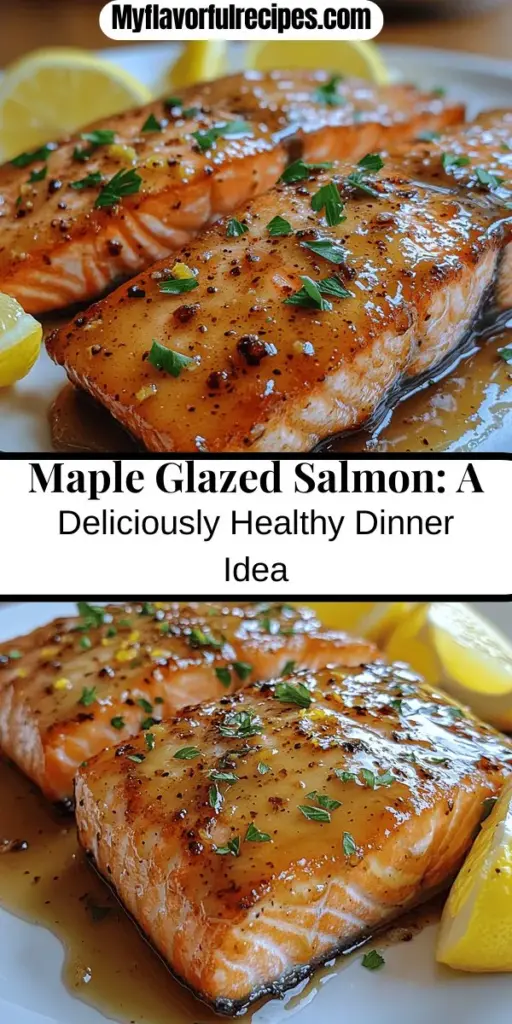When it comes to quick and satisfying dinner options, few dishes can rival the appeal of Maple Glazed Salmon. This delightful recipe effortlessly combines the rich, savory flavor of salmon with a sweet and sticky maple glaze, creating a dish that is both health-conscious and indulgent. Whether you’re a culinary novice or an experienced home cook, this recipe promises to impress with its simplicity, making it a perfect choice for busy weeknights or special occasions alike.
Salmon is not only delicious but also packed with nutrients, making it a staple in many dietary plans. With a flavor profile that balances sweet and savory elements, Maple Glazed Salmon exemplifies how healthy eating can be both enjoyable and satisfying. The blend of ingredients in this recipe not only enhances the taste but also provides significant health benefits, ensuring that you can indulge without guilt.
Understanding the Ingredients
To create a truly exceptional Maple Glazed Salmon, it’s essential to understand the role of each ingredient. Below, we delve into the key components that make this dish unique, along with their health benefits and culinary contributions.
Salmon
At the heart of this recipe is salmon, a fish celebrated for its robust flavor and impressive nutritional profile. Rich in omega-3 fatty acids, salmon is known for its heart-healthy benefits, including reducing inflammation and lowering the risk of heart disease. Additionally, it is an excellent source of high-quality protein, which is vital for muscle repair and growth, making it a perfect choice for anyone looking to maintain a balanced diet.
Salmon is also packed with vitamins and minerals, including B vitamins, potassium, and selenium. These nutrients contribute to overall health and well-being, making this fish not only a delicious option but also a nutritionally dense one.
Maple Syrup
Maple syrup serves as the star ingredient in the glaze, providing a natural sweetness that complements the savory elements of the dish. Unlike refined sugars, maple syrup is a natural sweetener that contains antioxidants and essential minerals, such as manganese, zinc, and calcium. Its unique flavor profile, which includes hints of caramel and vanilla, adds complexity to the dish, making it stand out from other salmon recipes.
When using maple syrup, it’s important to opt for pure maple syrup rather than imitation varieties, which often contain artificial flavors and added sugars. Pure maple syrup not only enhances the overall taste of the dish but also brings a touch of nature’s sweetness to your table.
Soy Sauce
To balance the sweetness of the maple syrup, soy sauce is introduced into the marinade. This ingredient is well-known for its umami flavor, which adds depth and richness to the dish. When choosing soy sauce, consider opting for a low-sodium variety to reduce the overall salt content without sacrificing flavor. The combination of salty and sweet elements creates a harmonious glaze that elevates the salmon to new heights.
Dijon Mustard
Dijon mustard plays a crucial role in this recipe by adding a tangy and slightly spicy note that cuts through the richness of the salmon. Additionally, mustard is known for its potential health benefits, including anti-inflammatory properties and digestive support. Incorporating Dijon mustard into the marinade not only enhances the flavor profile but also contributes to a well-rounded taste experience.
Garlic
Garlic is another essential ingredient in the Maple Glazed Salmon recipe. Renowned for its distinctive flavor and aroma, garlic also boasts numerous health benefits. It is rich in antioxidants and has been linked to improved heart health, immune function, and even anti-cancer properties. The inclusion of minced garlic in the marinade adds a savory depth that complements the sweetness of the maple syrup and the umami notes of the soy sauce.
Fresh Lemon Juice
Adding fresh lemon juice into the marinade introduces a bright acidity that helps to elevate the overall flavors of the dish. The acidity from the lemon juice not only enhances the taste but also helps to tenderize the salmon, resulting in a more succulent texture. Additionally, lemon juice is an excellent source of vitamin C, which supports a healthy immune system and enhances iron absorption.
Olive Oil
Olive oil is used in the marinade not just for its flavor but also for its health benefits. Rich in monounsaturated fats, olive oil is known for its heart-healthy properties and can aid in reducing inflammation. It also helps to create a luscious glaze that allows the flavors to adhere to the salmon during cooking, ensuring a beautifully caramelized finish.
Seasonings
Finally, a simple combination of salt and black pepper rounds out the marinade, enhancing the natural flavors of the salmon. Salt is essential for flavor enhancement, while black pepper adds a mild heat that balances the sweetness of the glaze. Together, these seasonings ensure that every bite of Maple Glazed Salmon is bursting with flavor.
The Marination Process
One of the most critical steps in preparing Maple Glazed Salmon is the marination process. Marinating not only infuses the salmon with flavor but also helps to tenderize the fish, resulting in a more enjoyable eating experience.
How Marination Works
Marinating is a culinary technique that involves soaking food in a seasoned liquid to enhance its flavor and texture. The science behind marinating lies in the interaction between the marinade and the proteins in the fish. The acid present in ingredients like lemon juice and vinegar helps to break down the protein structure, allowing flavors to penetrate deeper into the fish.
In the case of Maple Glazed Salmon, the combination of maple syrup, soy sauce, Dijon mustard, garlic, and lemon juice creates a flavorful environment that allows the salmon to absorb these delicious notes during the marinating process.
Suggested Marination Time
When marinating salmon, timing is crucial. While longer marination times can lead to more intense flavors, it’s essential to strike a balance to avoid compromising the fish’s texture. For Maple Glazed Salmon, a marination time of 30 minutes to 1 hour is ideal. This timeframe allows the flavors to infuse without overwhelming the salmon, resulting in a perfectly balanced dish.
Cooking Techniques for Perfect Salmon
Once the salmon has marinated, the next step is cooking it to perfection. There are several cooking techniques that can be used to achieve a beautifully cooked Maple Glazed Salmon, each offering its own unique flavor and texture. Whether you choose to grill, bake, or pan-sear the salmon, each method has its advantages.
Grilling the salmon imparts a smoky flavor and beautiful grill marks, while baking offers a hands-off approach, allowing for even cooking. Pan-searing, on the other hand, creates a crispy exterior while keeping the inside tender and flaky. No matter which method you choose, the key is to monitor the cooking time closely to avoid overcooking the salmon, which can lead to dryness.
With these insights into the ingredients, marination process, and cooking techniques, you are well on your way to creating a truly delicious Maple Glazed Salmon that is sure to become a favorite in your household. Prepare to impress your family and friends with this easy yet elegant dish that perfectly balances health and flavor.
{{image_1}}
Baking Salmon: A Healthy Cooking Method
When it comes to cooking salmon, baking is one of the healthiest methods available. This technique not only allows the fish to cook evenly but also helps to preserve its natural flavors and nutrients. Baking salmon minimizes the need for added fats, making it a great option for those looking to maintain a balanced diet while still enjoying succulent flavors.
Tips for Moist and Flaky Salmon
To ensure your salmon remains moist and flaky during the baking process, consider the following tips:
1. Preheat Your Oven: Always preheat your oven to the right temperature before placing the salmon inside. A consistent heat helps the fish cook evenly. For maple glazed salmon, a temperature of 375°F (190°C) works well.
2. Use a Baking Dish: Place the salmon skin-side down in a lightly greased baking dish. The skin acts as a barrier that helps retain moisture while cooking.
3. Cover with Foil: For the first half of the baking time, consider covering the dish with aluminum foil. This traps steam, keeping the salmon moist. Remove the foil in the last few minutes to allow the glaze to caramelize and develop a beautiful finish.
4. Check for Doneness: Salmon is best when it is cooked to an internal temperature of 145°F (63°C). Use a meat thermometer to check for doneness, but remember that residual heat will continue to cook the fish slightly after removing it from the oven.
5. Variations in Cooking Times: Cooking times will vary based on the thickness of your salmon fillets. As a general rule, plan for about 10-15 minutes of baking time for every inch of thickness. Thicker fillets may require additional time, so keep an eye on your salmon to prevent overcooking.
Creating the Maple Glaze
The star of this dish is undoubtedly the maple glaze. It’s essential to make this glaze from your reserved marinade, ensuring maximum flavor and safety.
Steps to Make the Glaze
1. Reserve the Marinade: After marinating your salmon, reserve a portion of the marinade for the glaze. Avoid using the marinade that has come into contact with the raw fish to prevent any contamination.
2. Boil for Safety and Flavor: Transfer the reserved marinade to a saucepan and bring it to a boil over medium-high heat. Boiling is crucial as it kills any harmful bacteria from the raw salmon. Additionally, boiling the marinade concentrates the flavors, resulting in a richer glaze.
3. Reduce for Consistency: Allow the mixture to simmer for about 5-10 minutes, or until it has reduced by half and has thickened to your desired consistency. You’re looking for a syrupy texture that will cling beautifully to the salmon.
4. Taste and Adjust: Before removing the glaze from the heat, taste it and adjust the seasoning as needed. If you prefer a sweeter glaze, consider adding a splash more maple syrup or even a pinch of salt to balance the flavors.
Serving Suggestions
Maple glazed salmon is a versatile dish that pairs beautifully with various sides. Here are some complementary options to enhance your meal:
1. Roasted Vegetables: Seasonal roasted vegetables like asparagus, bell peppers, or Brussels sprouts bring color and nutrition to your plate. Drizzle them lightly with olive oil, season with salt and pepper, and roast them alongside the salmon for an easy one-pan meal.
2. Quinoa: This protein-packed grain makes a fantastic base for your salmon. Cooked quinoa is light yet filling, and its nutty flavor pairs well with the sweet and savory glaze of the salmon.
3. Fresh Salad: A refreshing salad can balance the richness of the salmon. Consider a mixed greens salad with cherry tomatoes, cucumber, and a light vinaigrette to keep the meal light and fresh.
Tips for Plating
Presentation is key to an appealing meal. Here are some tips for plating your maple glazed salmon:
– Use a White Plate: A white plate provides a beautiful contrast against the deep, rich colors of the salmon and glaze.
– Layer Your Sides: Create height on the plate by layering your quinoa or grains on one side, with roasted vegetables beside it.
– Drizzle the Glaze: Before serving, drizzle any remaining glaze over the salmon and around the plate for visual appeal.
– Garnish: Consider garnishing with fresh herbs, such as parsley or chives, to add a pop of color and freshness.
Nutritional Information
Understanding the nutritional profile of your dish can help you appreciate its health benefits. Here’s a breakdown of the nutritional information for one serving of maple glazed salmon (approximately 6 ounces of salmon):
– Calories: 380
– Protein: 40g
– Fat: 20g
– Saturated Fat: 3g
– Carbohydrates: 15g
– Sugars: 10g
– Fiber: 1g
Benefits of Including Salmon in Your Diet
Salmon is not only a delicious choice but also a nutritional powerhouse. Here are some benefits of incorporating salmon into your weekly meal plans:
– Rich in Omega-3 Fatty Acids: Salmon is one of the best sources of omega-3s, which are essential for heart and brain health.
– High in Protein: A great source of high-quality protein, salmon helps in muscle repair and growth.
– Vitamins and Minerals: Salmon is packed with important vitamins and minerals, including vitamin B12, selenium, and potassium.
Conclusion
In summary, the maple glazed salmon recipe is an easy and delicious way to enjoy a nutritious meal at home. The health benefits of salmon, combined with the rich flavors of the maple glaze, make this dish a standout choice for any weeknight dinner or special occasion. With simple baking techniques and a few complementary sides, you can create a meal that is as pleasing to the palate as it is to the eye. We encourage you to try making this dish, savor the delightful flavors, and enjoy the wholesome, heart-healthy goodness of salmon.



